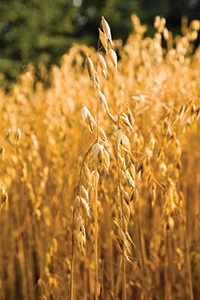
Technical Talk: January/February 2012
February 2, 2012
By Dr. John Michaelides
This good-for-you grass has a bevy of uses for your baking

|
|
| Oats have a shorter history of cultivation than other cereals, such as wheat.
|
Like wheat and other cereals, oats belong to the grass family. Botanically they are members of the genus Avena, along with wild oats. The most common species is Avena sativa. A number of other species are cultivated in specific regions of the world such as Ethiopia, Middle East and Brazil. Of particular interest is the species Avena nuda, called “naked oats” or sometimes “hulless oats.” Naked oats are of interest in recent years due to their nutrient composition and other characteristics. These species, although lacking inedible hulls, are covered with fine hairs and represent a problem for growers and the food processing industry. Dr. Vern Burrows of Agriculture and Agri-Food Canada (AAFC) developed a new variety of naked oats that is hairless. This variety has a promising future as a possible alternative to rice. It has similar processing, cooking and taste characteristics as rice but it is far superior in nutrition and health benefits. Research at AAFC indicates that these oats contain twice the protein, five times the iron and 10 times the fibre of white rice.
Oats have a shorter history of cultivation as wheat and other cereals. It is believed that present-day cultivated oats originated by way of a mutation from wild oats. A number of wild oat species are considered nuisance weeds, as they are difficult to control in cultivated cereal crops.
Oats are mainly a European and North American crop. They are mostly grown in cool moist climates, including Canada, Finland, Poland Russia and the United States. Oats were first introduced to North America in the early 17th century, along with other cereal grains.
The oat grain contains the endosperm, the germ, and the bran, similar to wheat grain. Although anatomically oats are similar to other grains, they are processed and consumed quite differently. Traditionally oats are consumed as a whole grain. In most cases processing ensures that the whole grain is included in the final product. In some instances oats are refined to make flour and bran, but most processing involves making flakes that are a product of the whole grain. Unlike wheat and rice, where the germ is removed to ensure longer shelf life for the final product, this nutrient-dense component in the grain remains in oats after processing. In the mill, oat grains are cleaned and then dehulled to remove their tough, inedible husks. These husks can be diverted to the production of dietary fibre that can be added to food products. In Canada these can appear as fibres on a food label. After the removal of the hulls, the grains (called groats at this stage) pass through a steam treatment for kilning. Kilning exposes the groats to temperatures up to 105 C (221 F) for about two hours. This ensures the oats will have a long shelf life. Due to the presence of the germ and the fact that oats contain higher amounts of lipids than other cereals (about seven per cent) this step is necessary to deactivate the enzymes responsible for lipid oxidation and the onset of rancidity. Following kilning, the groats can be cut to make steel cut oats, or further processed into larger flakes. Steel cutting uses stationary knives in rotating drums to produce smaller pieces of groats. The size of the flake is determined by the size of the groat pieces. Flaking involves several steps. The groats are first steamed to soften them, minimizing breakage and ensuring further deactivation of enzymes. They are then passed through rolls with openings that determine the thickness of the flakes. This process produces flakes of different thickness; the thickness of the flake determines the time the consumer will require to cook the flake. Oat flakes are sold as finished products to consumers or as ingredients to consumers and food manufacturers.
Milling the groats makes other oat products such as bran and flour. These are used as ingredients in various foods. In addition, finely ground oat flour can be an ingredient in skin-care products.
A lot of research has been carried out on the health benefits of oats, specifically their soluble dietary fibre and its role in preventing cardiovascular diseases. The late Dr. Peter Wood of AAFC carried much of the pioneering research on this fibre out. Health claims on the effect of oats in our diet and the prevention of cardiovascular disease are permitted in both Canada and the United States. Further clarification with regards to such claims is available on the Canadian Food Inspection Agency’s website. Beyond the health benefits, oats and oat flour provide functionality in formulations. Due to their higher fat content when compared to other grains, oats can improve mouth feel and extend a product’s shelf life, two very important things to bakers.
Oats are a valuable cool climate crop with substantiated health benefits long associated with breakfast cereals. As ingredients, whole or in part, they provide many options to product developers and consumers.
For more information, or fee-for-service help with food technical and processing issues and needs, please contact Dr. John Michaelides at John Michaelides & Associates at 519-743-8956, at Bioenterprise 519-821-2960, ext. 226, or by e-mail at j.jmichaelides@gmail.com. Bioenterprise is a company of experienced professionals that coach and mentor emerging agri-technology companies from planning to startup to profitability and beyond.
Print this page
Leave a Reply